25 Fabulous Things To Do in Cordoba Spain
Are you planning a trip to Spain? The City of Three Cultures, should be at the top of your list. On a recent visit, I discovered a wealth of things to do in Cordoba. In fact, I also found the most inspirational building in all of Europe!

Tucked into the heart of Andalusia, Córdoba receives less tourists than its more famous neighbors of Seville and Granada. Located in stunning southern Spain, this city’s hidden treasures are numerous, just waiting to be discovered.
Approximately 300,000 residents now call this modern city home. While it’s true that the cultural legacy left from medieval times is deep and powerful, this destination provides a great combination of Moorish references, 10th century architecture and the new modern conveniences tourists are expecting.
Delicious, charming, and colorful. Emirs, philosophers, and scientists. Cultural depth, authentic food, quality museums, Moorish architecture and flower gardens bursting at the seams…….These are the words that come to mind when I recall my time in the city. A visit to Cordoba is a must for those wanting to experience genuine Spain. Córdoba was once the greatest capital city in Europe.
In this guide, you’ll find:
- When to Visit Córdoba, Spain
- How to get to Cordoba, Spain
- What to do in Cordoba, Spain
- Where to stay in Cordoba, Spain
When to Visit Córdoba
To say Córdoba was sweltering when I visited in June is a bit of an understatement! The thermometer clocked in at 104° midafternoon. Residents seem to take it in stride, but be aware that Córdoba has a hot, Mediterranean climate with humid summers. Temperatures do drop in the evening to something more manageable.
The hottest month is July and its highs average around 98 °F (36.9 °C) but can be as high as 104 °F (40 °C). In August, temperatures start to drop.
Winter lows are at the lowest in January at 39 °F (3.9 °C) and the January high is around 58°F on average (14.4 °C). The coolest time of year is from November to late February, where the daily high temperature is below 65°F (18.3 °C).
The chance of rainfall tends to run from late September through late May, and the wettest month of the year is in October.
Summer is a popular time to visit, though also the hottest and most humid. The best time of year to go will depend on your tolerance for humidity and if you want to risk a little rain during your visit. Whenever possible, I always love to travel during the shoulder seasons. It helps the destination become more sustainable year-round and prices are usually lower.
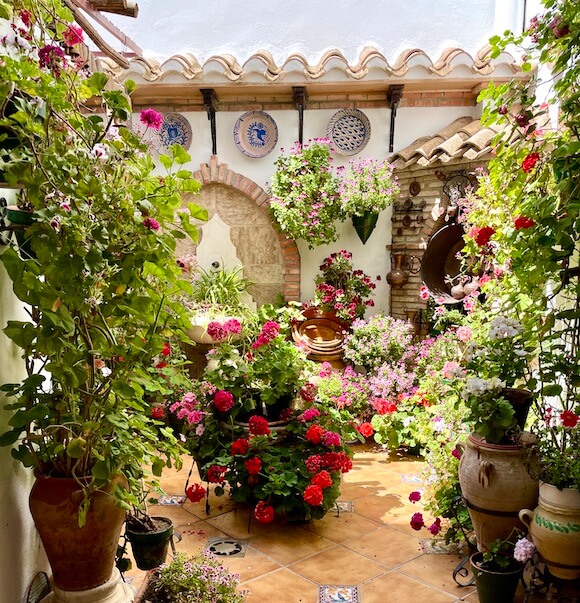
One of many gorgeous courtyards in Córdoba.
Getting to Cordoba
The closest international airports to Cordoba are Malaga and Seville.
The fastest way to get to Cordoba is by rail. The city is easy to reach by high speed AVE train from Seville in under an hour. Madrid is under 2 hours. Dozens of Cordoba-bound trains depart Sevilla-Santa Justa every day, with prices ranging from around 11 to 34 euros depending on the time of day and the type of train.
The high-speed AVE, AV City, and Avant trains will get you there in about 45 minutes, whereas slower trains like the Media Distancia (MD) can take up to an hour and 20 minutes. You can get your tickets online via the RENFE website, or in person at the station.
Another option is to take the bus, operated by Alsa. This is a great budget-friendly option but run less frequently than the trains and often take up to two hours (depending on departure point) with stops along the way.
Renting a car of course gives you the most flexibility and you can make your own schedule. Cordoba is just a quick 90 minute drive northeast of Seville along the A-4 highway.
Getting around Córdoba
Córdoba is easy to navigate and fairly compact. Most attractions are reachable on foot, especially in the Old City. There is also a Córdoba City Sightseeing Hop-On Hop-Off Tour Bus which offers a 24-hour ticket and travels to many attractions first timers will want to see.
Now that you’ve figured out the transportation and what to pack for the weather, it’s time for the most enjoyable part of trip planning: researching the favorite things to do in Córdoba, Spain and planning an unforgettable visit to this unique city.
25 of the Best Attractions in Córdoba, Spain
Few would argue with the fact that during the Middle Ages Córdoba was one of the most important capital cities of Europe. That glorious past contributes to its seductive power as a timely destination for today. A fascinating Andalusian city offers the visitor an opportunity to feel the magic of what it might have been like to live in a place where religious tolerance was embraced.
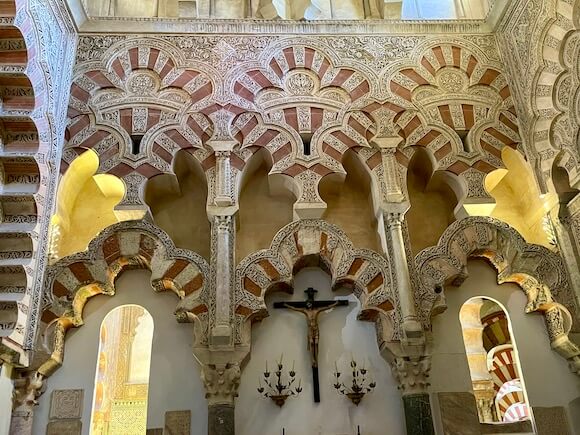
Interior wall of La Mezquita (Mosque/Church)
UNESCO World Heritage
If UNESCO World Heritage sites are part of your travel bucket list, lucky you! Four additional sites can be crossed off your after a visit. Córdoba is currently the city that houses the most UNESCO World Heritage titles in the world.
In 1984, the Mosque-Cathedral of Córdoba made the list; in 1994 the surrounding historic center was added. The Fiesta de los Patios Cordobeses was designated Intangible Cultural Heritage of Humanity in December 2012. Finally, in July 2018 the city of Medina Azahara, on the outskirts of the urban core, was also declared a World Heritage Site.
The Great Mosque – 1984 (Extended to include the Historic Center of Cordoba in 1994)
Alcazar of Cordoba – 1994
Patios Festival – 2002
Medina Azahara – 2018
Mudéjar Style
Visitors will quickly become aware of the term Mudéjar. It refers to a style which is unique to the history of Spain. This is the confluence of Christianity and Islam. As the Reconquest moved through southern Spain, the Muslims who stayed and practiced their religion worked their artistic talents on the continuing architecture and arts.
The style, incorporating techniques, materials and formal elements was influential in the Romanesque, Gothic and Renaissance styles. Evidence of Mudéjar workmanship can be seen today in Castile-León, Toledo, Seville and Córdoba.
La Mezquita (The Great Mosque)
Topping the list of places to see in this stunning city is one of most beautiful and important buildings in the world. The spectacular structure of La Mezquita also lands as No.1 of my favorite monuments in Spain. Capturing 1000 years of history in a single site, this exceptional space presents a world map of religious tolerance, unique architecture and global history.
Declared a UNESCO World Heritage Site in 1984, the Great Mosque was built in 785 AD by Abd al-Rahman. The Arab prince arrived in Cordoba and transformed the city into a marvel revered by all of Andalucía. In addition, by introducing irrigation, he also changed the surrounding landscape.
When visiting the mosque/church, tourists walk in awe around the 850 columns; they follow in the footsteps of pilgrims who circled in prayer seven times a day. The well-worn cobblestones are smoothed to a glossy patina reflecting the marble, jasper, granite and onyx of the surrounding archways.
Over the years, during each new reign of power, different rulers would add to the mosque, leaving their mark on the vast structure. The breathtaking and elaborately ornamented prayer niche, or Mihrab, was added by Abd-ar-Rahman III in 912AD. It held a coveted copy of the Quran and faces Mecca.
Our informative guide illustrated the overall acceptance of different religions. The gold leaf covering the Mihrab was a gift from Christian Byzantium. The name Jesus is penned in calligraphy 99 times in the ceiling, perhaps a reference to the 99 names of Allah in the Quran. There is much food for thought contained within this richly ornamented structure now the size of four football fields.

Ceilings from the Mosque area (left) and Church area (right)
After the Christian Reconquest in 1236AD, the Mosque remained relatively unchanged architecturally for nearly 300 years even though it was now used as a Catholic church. King Carlos I made it “official” in the 16th century by adding a chapel and choir creating a unique space where you can go to a Christian Mass inside a mosque.
Aside from the spectacular beauty of its interior, La Mezquita is most importantly a reflection of the Golden Age of Córdoba, a time of peaceful co-existence between a population of different faiths and cultures. It is a sight to be savored.
Try to get there when it first opens in the morning.
Judería (Old Jewish Quarter)
The melting pot better known as Andalucia continued as a place of rich cultural heritage until 1492. In that year, the fall of nearby Grenada marked the end to a rich and fairly peaceful Islamic rule.
As the Mezquita illustrates above, Cordoba was one of the most free-thinking examples of tolerance between three different religions in Spain: Judaism, Christianity and Islam. Visitors can find examples of the region’s Jewish Quarters in Cordoba, Seville, Lucena and Jaén.
Declared a World Heritage site in 1994, the area in Córdoba forms an integral part of the historical center. Highlights include Calle Judios, the House of Sepharad-House of Memories, Plaza de Tiberiades, the statue of Maimónides and the Synagogue.
The urban design mirrors a traditional Islamic city layout during Medieval times. Two core intersecting streets are surrounded by a warren of smaller alleyways and dead ends. The resulting labyrinth is filled with interesting stops for the visitor. Wander amongst the unique storefronts, traditional crafts shops, and delicious restaurants. Touristy yes, but still very charming and pretty.
Maimónides
The Plazuela de Tiberiades is centered on the statue of Maimónides (1138-1204), a rabbi, scholar, mathematician and physician. He became one of the most influential Torah scholars of the Middle Ages. Historians credit him with the general principle of alleviating poverty by facilitating self-sufficiency. Today, the famous quote: “Give a man a fish and you feed him for a day; teach a man to fish and you feed him for a lifetime” is based on his original concept of charity.
Jewish Synagogue
The City of Three Cultures left in its wake the Mudéjar style, an unusual combination of architecture. Situated in the heart of the Jewish Quarter is the synagogue built in this style in 1315. It is one of three remaining synagogues in Spain from the medieval period.

Interior of Jewish Synagogue in Juderia
Though small in stature, the prayer room is beautifully decorated by talented craftsmen from the 1300’s. After the Jews were expelled from the area, the building has survived life as both a hospital and a nursery school. Today the synagogue has been returned as a place of historical legacy on the Iberian Peninsula
The Courtyard Patios of Córdoba
If you think you know courtyards, think again. The residents of Córdoba have given new meaning to the concept. Some of the remaining structures date as far back as the 10th century. With a hot and dry climate, the Romans first adopted the idea of making the center patio, usually complete with fountain and/or well, as the heart of the home. Later, Muslim culture further enhanced their useful beauty by adding plants, gardens and flowers. These spots of greenery and water became the Arab oasis, an essential ingredient to surviving in the desert.
In the area visitors will find two types of courtyards:
- Most familiar is probably the single family house where rooms are arranged around the central atrium. Arches normally lead to the outer rooms and the floor is tiled or made of decorative and patterned stones.
- The Casa de Vecinos, or neighbors house is made up of several homes and multiple families living under the communal roof around the center courtyard. Although much less common nowadays, this was a way for families to cut costs and have a joint well in the center for water and washing. Usually having two floors, the balconies and staircases added to the openness of the structure. Baked clay tile roofs and decorative floors were also customary.
Cordoba Patio Festival
One of the most popular tourist attractions in Córdoba is the Patio Festival. Each year in May the city hosts the Fiesta de los Patios. Andalusian folklore is in full force with traditional flamenco dancing and vocal performances. Patio owners celebrate by decoration their iron gates and balconies with a host of flowers and ivies.
These welcoming spaces are privately owned, but for the week of the festival, a contest brings out the most creative and colorful brush strokes of the owners painting with geraniums, carnations, ivies and roses. It is a rich privilege for the public to be invited into this world of spring splendor.
Several of the homes remain open after the festival and are revealed with signage. The public can enter and a small donation is requested for maintenance.
The concept of the patios spills out on to the walls of the alleyways. Wandering the streets of the Alcázar Viejo and Santa Marina districts will give you a feel for the intimate patios. Make sure not to miss the Alley of the Flowers in the Jewish quarter. The most elegantly decorated historic examples in Córdoba can be seen in the Palacio de Viana featuring 12 exquisite courtyards and a garden all in a single location.
Palacio de Viana
The simple exterior of Palacio de Viana gives no hint of the treasures housed inside this former house of Spanish nobility. The collection of family heirlooms, mosaics, Azulejos tiles, artwork and furniture come alive in actual settings from its former life as a palace.
Open as a palace/museum for the public more than 40 years ago, the building began its life with the royals in the 15thcentury and continued as a palace until 1980. Throughout the years, 18 different owners lived in and slowly transformed the interior.
The Fiesta de los Patios gave us an idea of the priority Córdoba places on patios and gathering spaces. At the palace of the Marquises of Viana, visitors will find the largest concentration of courtyards all housed within the same building. Each of the beautiful outdoor rooms are filled with water features and gorgeous plantings and gardens. I especially loved the orange trees and Lady’s Courtyard but would be hard pressed to pick a favorite among the twelve garden highlights housed within.
Today, the Palacio represents a wealth of heritage for the area. Not unlike La Meziquita which narrates a story of 1000 years, Viana’s historical archive covers 500 years and is an attraction not to be missed in this ancient city.
Address: Don Gomé Square, 2
14001 Cordoba SPAIN
Alcázar de los Reyes Cristianos
The term Alcázar is Spanish for castle or fortified palace, usually the residence of the king. Arabic in origin, the prefix al when combined with qasr combines to mean palace.
Located not far from the Mezquita, the Alcazar de los Reyes Cristianos was originally built as a fortress in the 1300’s. Surrounded by gorgeous gardens and incorporating water features, the Mudejar style site was used as the residence of Queen Isabella and King Ferdinand. They laid plans here to defeat the last remaining Muslim ruler of Granada.

Exterior of Alcazar Cordoba, Spain
Christopher Columbus was hosted here when he requested funds to explore the New World. For nearly 300 years, the Spanish Inquisition was headquartered here as well.
Today, the structure of the castle remains inside the walls surrounded by swaying palm trees. Climb the tower for a bird’s eye view of the cityscape and overhead of the palace gardens. The Palace of the Christian Kings is one of Cordoba’s four UNESCO World Heritage Sites.
Address: Plaza Campo Santo de los Mártires, Córdoba
Puente Romano (Roman Bridge) and Calahorra Tower
Game of Thrones fans have chosen the right destination when they visit Spain. They are sure to recognize the Roman Bridge as the setting for the fictional city of Volantis! Originally built in the 1st century BC across the Guadalquivir river, it has been reconstructed over the years. For 2000 years it was the only bridge across the river and is quite a dramatic sight to see lit at night against the backdrop of the city.
The southern end of the Roman Bridge is where you’ll find the Calahorra Tower. Parts of the structure were rebuilt in the 12th century. Declared a historic-artistic monument in 1931, restored again in 1954, the tower currently houses the Living Museum of al-Andalus, celebrating the peaceful coexistence of three cultures in the city.
Web Address:
https://www.torrecalahorra.es/
Puerta de Almodóvar
In Roman times, the importance of a city was often measured by the number of gateways or entrances built into the fortifying wall. Cordoba’s original seven spoke to the importance of the location.
Unfortunately, only one of the original arched openings remains. The Puerta de Almodóvar is a remarkable structure along the original Roman wall. These walls were built when the Romans conquered the city in 206 BC and now form part of the well-preserved historic center.
The Roman Baths
The baths provide and interactive experience to immerse yourself in the wonderful history of Cordoba. The perfect place to recharge before your journey onward is the Hamman Banos Arabes. This holdover from the Moorish culture, a gathering place for greeting, mingling, gossip and of course bathing is an invigorating reminder of the importance of wellness in your travels.
Emphasizing the place of prominence water plays in all cultures, the hammam represents life and spirituality of all who traveled this path before us. Make sure not to miss the traditional Kessa where you’ll be scrubed within an inch of your life. Amazing to have this part of the experience mimic the hammams I had in both Jordan and Turkey! You will leave positively glowing.
Indulge in Cordoban Gastronomy
What could be a better reason for visiting than the excellent gastronomy? The essence of different cultures that have passed through this region is inherent in the flavors and recipes of Córdoba. Discover the influence and exotic mix of the Romans, Arabs and Jews.
Make sure to taste the “golden liquid” of the surrounding olive groves. Making the most of ingredients from the surrounding mountains and countryside, the taverns and restaurants offer the deliciousness and health factor of the Mediterranean diet. In fact, Cordoban Gastronomy has recognized by UNESCO as the Intangible Heritage of Humanity since 2013.

Cordoba’s Mercado Victoria-so many tastes!
Córdoba Flavor Tasting at Mercado Victoria
Sightseeing can work up quite an appetite and the perfect solution for an epic, casual tasting of Cordoba is the Mercado Victoria. This food hall brings the flavors of Andalusia into one location and promises your tastebuds will leave filled with gastronomic pleasure.
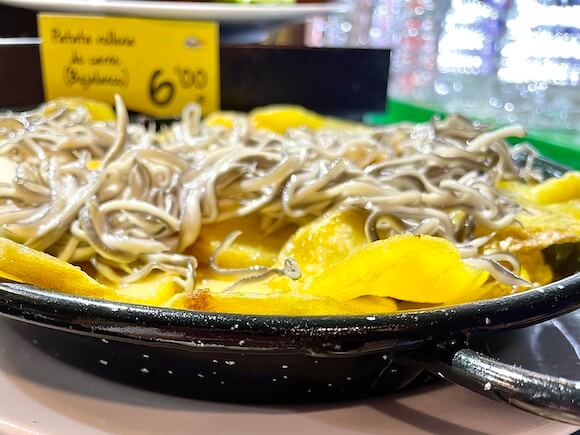
Nido de patatas at Mercado Victoria
Was it possible for me to try another bowl of salmorejo? What about oysters and champagne or Cordoba’s take on sherry with a glass of Montilla-Moriles wine? Empanadas–check, sardines–check, nido de patatas–check. All this and so much more awaits at this fun venue! (plus it’s just a quick walk to my hotel and a roll into bed!)
Royal Stables Horses
Equestrians in the know are well versed in the fine Andalusian horse, also known as the Pure Spanish Thoroughbred or PRE. The breed has lived on the Iberian Peninsula for thousands of years. Prized by nobility, King Phillip II laid the foundation for the horses’ future role in war and dressage when he created the Royal Córdoba Stables in 1570 on part of the site of the city’s Alcázar fortress.
The Royal Herd was born through a breeding program of the best mares and stallions from the surrounding provinces. The city became known globally as the World Center for Horse Breeding.
Known for their different dressage skills, observing them in action is a thing of beauty. I had the privilege of watching a performance of the Equestrian Show at the Royal Stables after a private tour of the facility. Both horse and trainer seem to become one during what I can only describe as a horse ballet. The spirit, choreography and skill level are remarkable. When looking for things to do in Córdoba, I highly recommend a visit to see this iconic symbol of the Spanish Empire.
Address : Calle Caballerizas Reales 1, Córdoba, 14014
Traditional Handicrafts
I love to research local crafts before I arrive in a new destination. When looking for souvenirs when we travel, shopping for indigenous crafts contributes to keeping LOCAL cultural heritage alive. Cordoba has a rich tradition of handmade products. Leather and silverwork are at the top of the area’s artistic legacy. In addition, visitors can find pottery and ceramics. Cordoba is also known for beautiful, classical guitars and of course the Cordoban hat.
Silver
In the capital city, visitors will find the largest number of silver workshops in Spain. Craftspeople are particularly known for their filagree work. While silver is the traditional metal of choice, new elements have been introduced for a wider variety of designs.
Leather
Another thriving tradition is the artistic guadamecil style of leatherwork. This time consuming craft is a form of leather engraving producing exquisite polychromed detail with patterns of embossed silver. The workmanship is highly skilled and reminded me of the finest details from silk carpets. Make sure to stop at the Casa Museo del Guadamecí Omeya a workshop and museum dedicated to the restoration of Umayyad Caliphate (10th century) and the techniques developed in Córdoba.
The craftsmanship that goes into the leather work outfitting the Andalusian horse experience is highly skilled and detailed. Any serious horse person could find a very special piece in the workshops here.
Address: Plaza Agrupacion de Cofradías, 2 · 14003 Córdoba Spain
Códoban Hatmaking
Tourists will immediately recognize the Córdoban hat. Worn by horse riders and flamenco made from felt, the wide, flat brim and low crown is an iconic symbol of traditional Andalucian dress. There are few remaining ateliers continuing the craft, one can be found in the city still producing these millinary gems using original tools from the 19th century.
Address: Sombrereria Hermanos de J Russi. C/ Ambrosia de Morales,1
Additional Places of Interest :
-
Museo Arqueológico de Córdoba
Address: Plaza de Jerónimo Páez, 7, Córdoba 14003
-
The Julio De Torres Museum
Address: 1 Plaza Potro, Córdoba
-
Iglesia de San Miguel
Address: Plaza de San Miguel, Córdoba 14002
-
Jardín Botánico de Córdoba
Address: Avenida de Linneo, Córdoba
Where to Stay in Cordoba
I was hosted at the Eurostar Palace, a luxury hotel with a great location. The rooftop pool was a welcome respite from Córdoba’s heat and a great spot to recharge and cool off before dinner. Centrally located at the edge of the historic distric, the hotel is a great base from which to explore all of Coroba’s attractions. The breakfast buffet offers a fantastic selection of options.
Additional Information
Conclusion
Modern day Cordoba might live in the shadow of its glorious 10th century past, but as you can see, this present-day charmer in Andalusia has a heady mix of past and present. Where else in the world can you step back in time to a place where religious tolerance thrived?
Today, modern restaurants reinvent ancient recipes with traditional flavors from Romans, Arabs and Jews, in delicous ways. Colorful patios overflowing with blossoms are discovered around every twisting, whitewashed alleyway. The varied selection of things to do in Cordoba is certain to captivate all who visit. The Pearl of Moorish Spain should not be missed on your next European holiday.
Disclosure: I visited Cordoba, Spain as a guest of the Andalucia and Cordoba Tourism Boards. Many thanks to my host Philipp Heuri Temboury and our guide Rafael Soldevilla who both showed our group the many treasures and tastes Cordoba has to offer. As always, opinions and thoughts are my own and not influenced or edited by outside sources.
Save for Later ♥ Pin Me




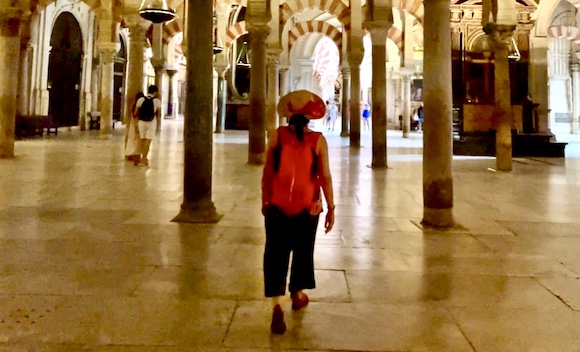
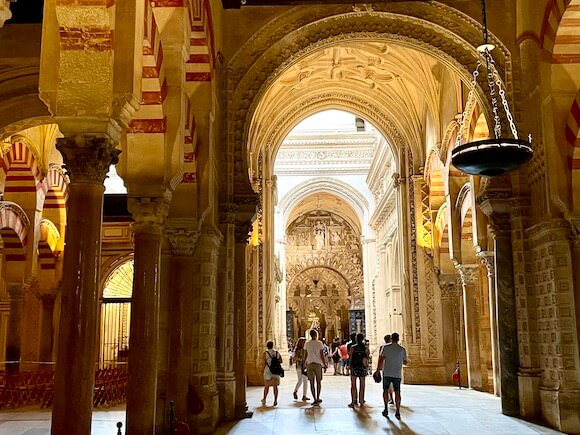
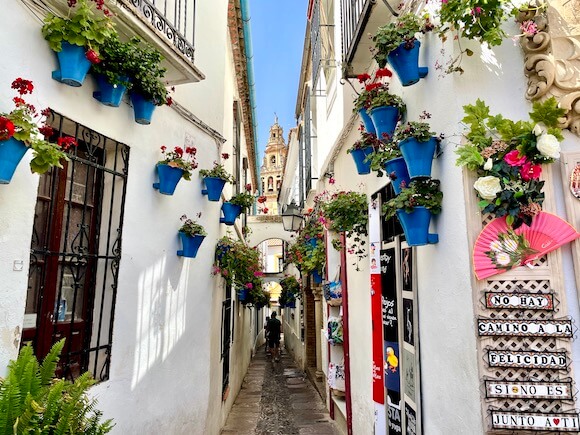


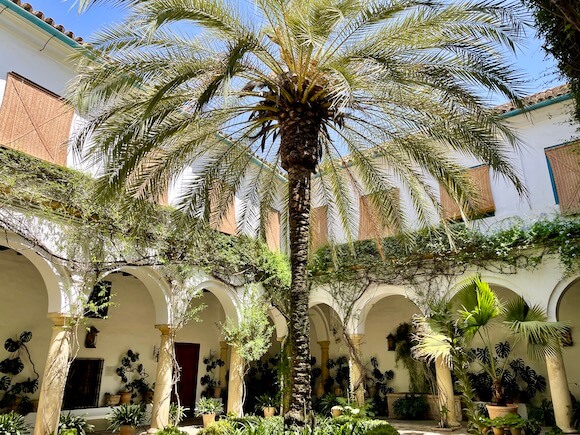

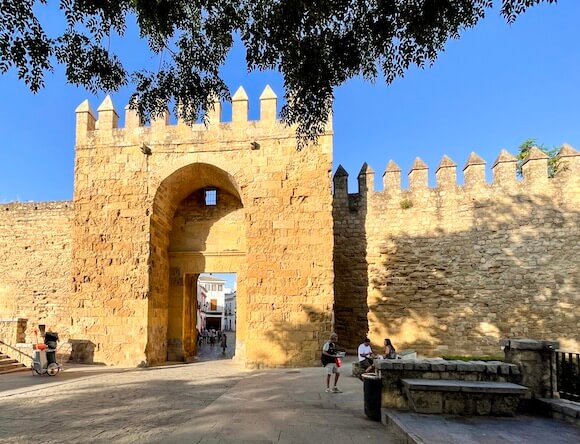
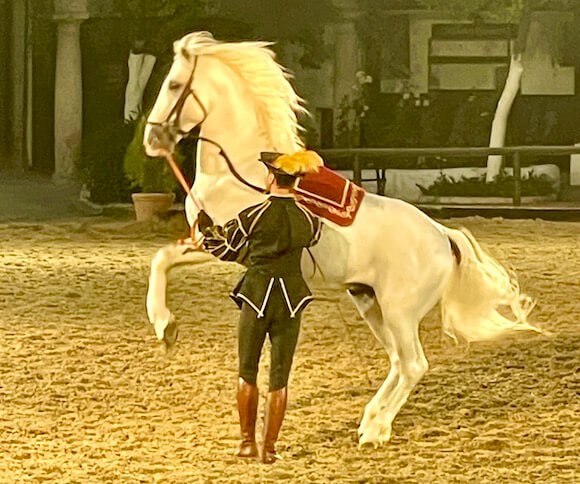
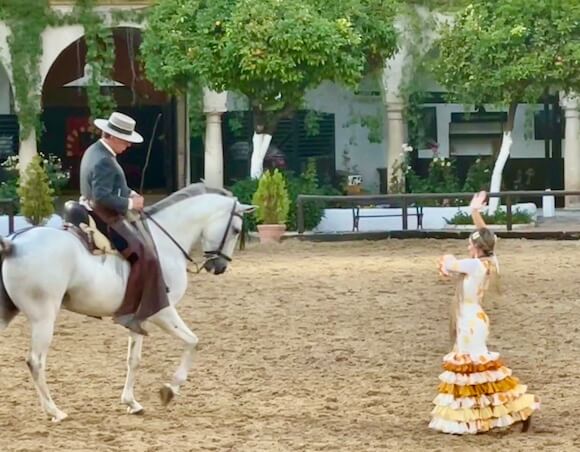
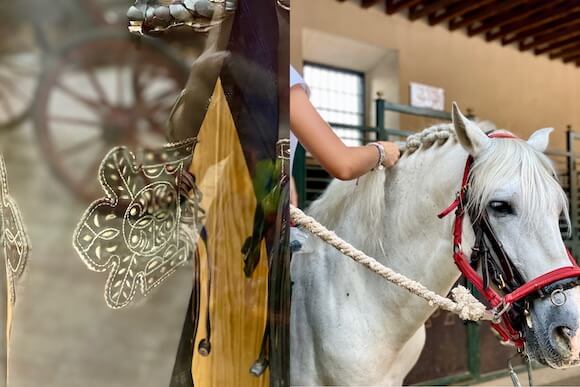
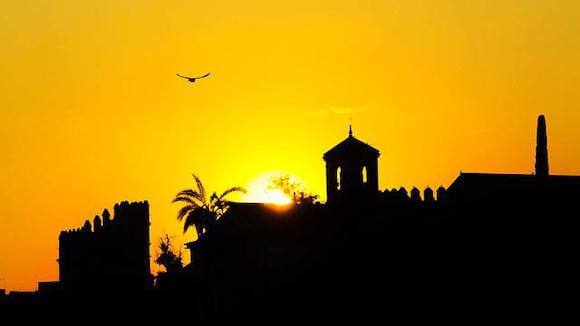
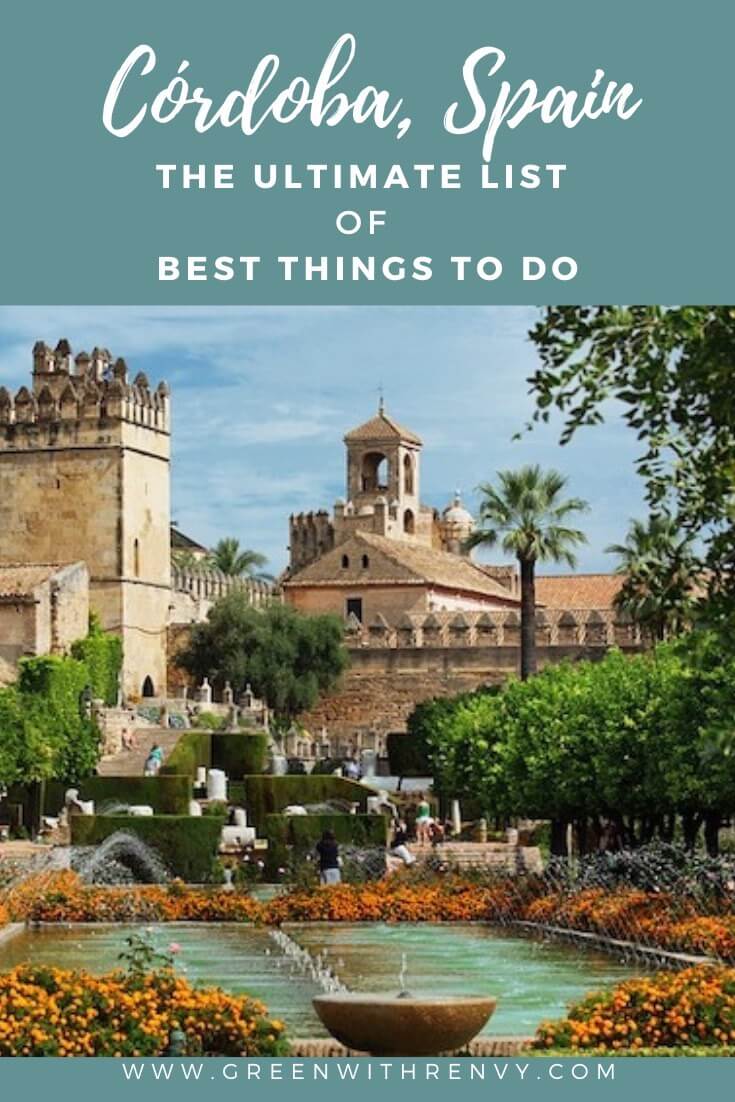




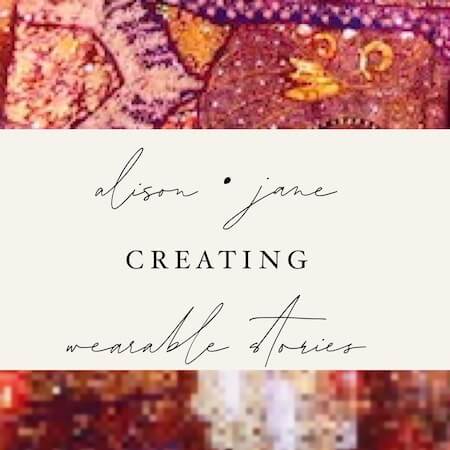
















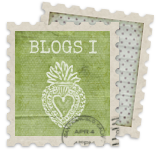



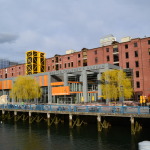








Amazing guide, Alison! Indeed, Cordoba is one of those places that usually gets overlooked when planning a trip to Spain but it is definitely worth the visit. Absolutely gorgeous city, packed with history and the food is just unforgettable. Thanks for sharing 🙂